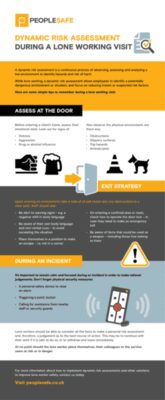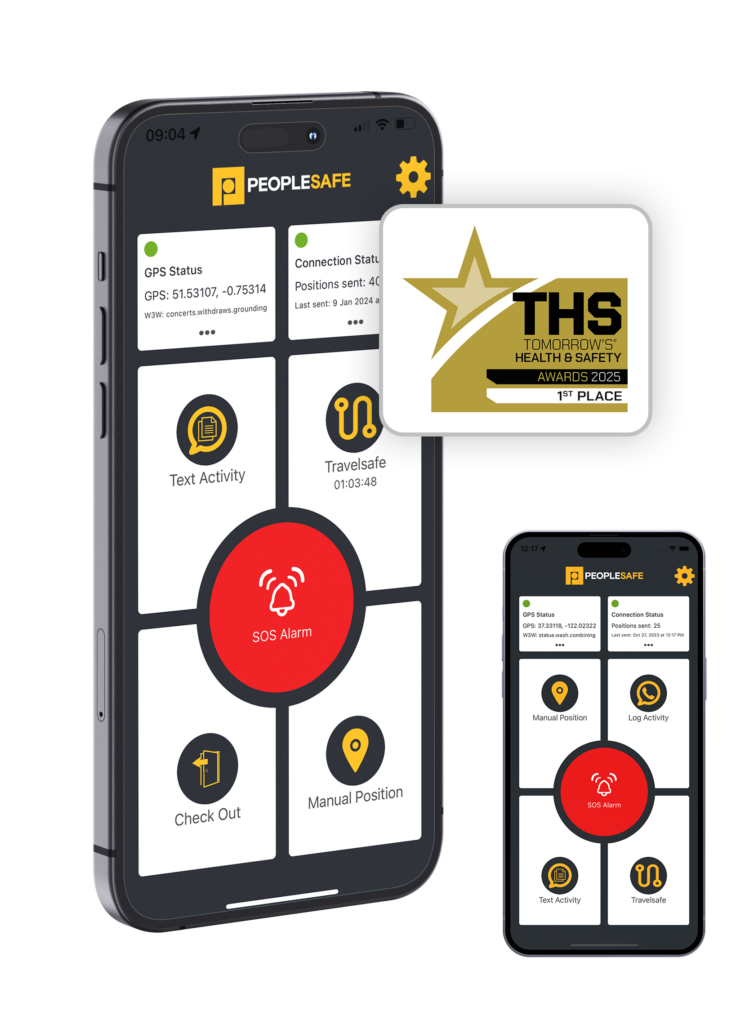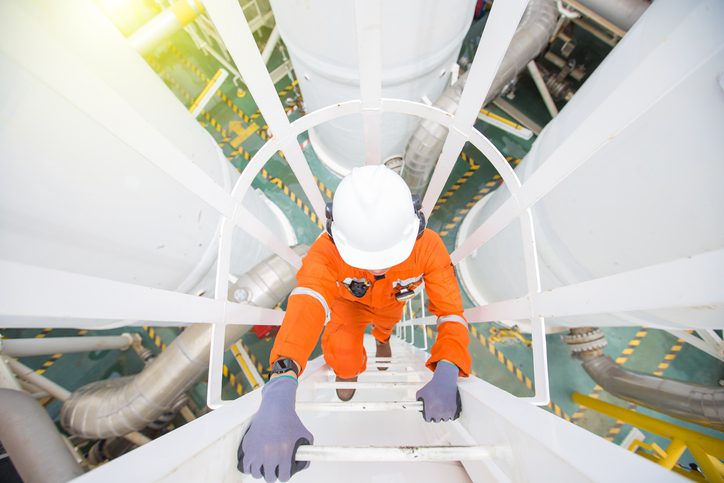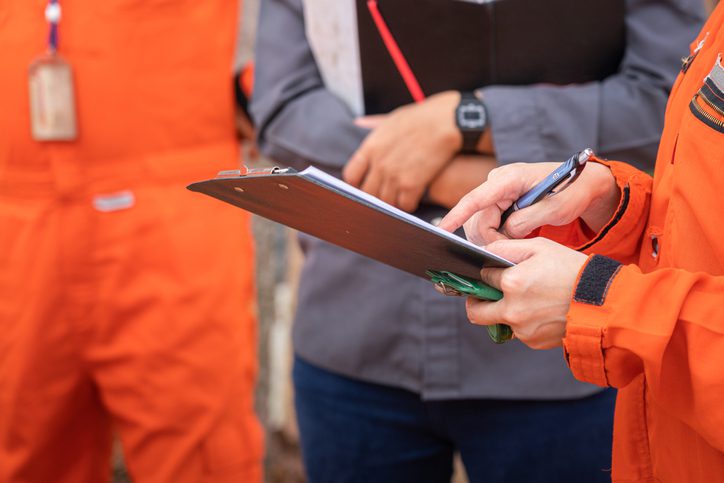What Is a Dynamic Risk Assessment?
A dynamic risk assessment (DRA) is a continuous process of identifying and analysing risks in real time while working. It builds upon existing risk assessments but is conducted in the field, usually by the worker performing the job to ensure their safety. Dynamic risk assessments are used to assess unpredictable or changing factors that may not be known beforehand so that workers can safely navigate these challenges.
Most unpredictable risks fall into 4 categories:
- Human Factors – Risks associated with human behaviour can’t be predicted in advance, this includes fatigue, stress, aggression and emotional sensitivity.
- Environmental Factors – Natural disasters, extreme weather conditions, or environmental incidents can happen suddenly and present unforeseen risks.
- Equipment or System Failures – Malfunctions with work equipment or systems can happen at any time.
- External Threats – External sources, such as criminal activities, terrorism, or political events can arise unexpectedly and present new dangers.
The main purpose of a dynamic risk assessment is to identify if measures can be put in place to make the situation safer, or if it is too dangerous to proceed. This could involve delaying work until safety measures have been put in place or walking away completely.
By encouraging workers to identify hazards as they arise, dynamic risk assessments enable individuals to respond appropriately and make quick safety decisions. So, while not legally required, dynamic risk assessments allow workers to assess risks on the spot and maintain a safe work environment for themselves, colleagues, and others.
They provide a framework for accurately identifying, assessing and controlling workplace hazards. This helps to create a culture of workplace safety and equips employees with valuable skills to evaluate unforeseen hazards and take appropriate action.
What is the Difference Between a Risk Assessment & a Dynamic Risk Assessment?
Traditional risk assessments are conducted in advance before any employees begin work. These must be updated at least annually and for organisations with more than 5 employees, they are required by law to be recorded. These assessments act as a basis for establishing health and safety guidelines and procedures.
Conversely, dynamic risk assessments are carried out on the spot, for example, while work has already begun but new risks have been identified. These do not need to be recorded, although it is best practice that any findings as a result of a dynamic risk assessment should be communicated to those managing health and safety within the organisation.
Dynamic risk assessments should not be seen as a replacement for formal risk assessments. While formal risk assessments are conducted in advance to establish safety guidelines, dynamic risk assessments complement them by addressing unforeseen risks. Both types of assessment are necessary for comprehensive risk management.
How to Conduct a Dynamic Risk Assessment (DRA)
There are 6 steps to follow to ensure your dynamic risk assessment covers all bases:
- Assess before entering – Prior to entering a situation or environment, take a moment to assess the surroundings and the potential risks associated with it.
- Identify potential hazards and risks – Identify risks as they occur e.g., a customer becoming aggressive or a faulty piece of equipment. Employees should also be aware of the difference between hazards and risks. A hazard is something that has the potential to cause harm, while a risk is the likelihood and severity of harm occurring.
- Consider the outcome – Evaluate who or what may be affected by the identified hazards. Could there be damage to equipment or property? Is there a risk of injury or even fatality to individuals involved? How serious is the risk? What is the consequence of the work being postponed?
- Trust your gut – Instinct plays a vital role in identifying risks. Employees should be encouraged to trust their instincts and leave an environment if they feel uneasy, unsure, or afraid.
- Take action to manage the risk – Once risks are identified, it’s important to take action to mitigate or reduce them. This may involve seeking assistance from others, setting specific time limits for activities, or activating a SOS alarm. Employees should also always have an exit strategy in mind and consider any blockers.
- Decide whether to proceed with the task – Based on the assessment and risk management actions taken, make a decision on whether it is safe to continue with the task at hand or if it should be postponed or cancelled.
By following these steps, employees can conduct effective dynamic risk assessments that help them to safely navigate potentially hazardous situations.
However, in order to provide employees with the confidence and knowledge required to conduct a dynamic risk assessment, thorough training is necessary. This should cover how to evaluate risks, how to determine an appropriate course of action and when to walk away from a dangerous situation.
For those working with the public, this could also involve how to effectively interact with the public to detect signs of aggression and frustration, as well as conflict resolution tips.
Download the infographic
Who Might Need to Conduct a Dynamic Risk Assessment?
Dynamic risk assessments are applicable to a wide range of industries and professions where the nature of work involves constantly evolving or unpredictable risks. However, they are particularly important for lone workers as they don’t have colleagues nearby to help assess risks or provide support if an incident does occur.
Roles where conducting a dynamic risk assessment may be necessary include:
- Care workers
- Estate agents
- Construction workers
- Retail staff
- Hospitality workers
- Hospital staff
- Security staff
Why are Dynamic Risk Assessments Important?
Some workers are required to work in environments outside the employer’s control, such as client’s homes. In these instances, a formal risk assessment is not able to identify all the hazards the worker is likely to encounter. Where risks are constantly changing, a dynamic risk assessment can prevent employees from remaining in potentially dangerous environments or have the skills to remove the risk before an incident occurs.
By training employees to carry out dynamic risk assessments, organisations ensure that their workforce understands the ever-changing nature of risks. This empowers employees to actively identify potential hazards that may pose harm and take necessary precautions to avoid incidents. This also helps to develop health and safety culture within the organisation, which can have a positive impact on productivity and morale. Dynamic risk assessments play a vital role in maintaining a safe working environment and protecting the wellbeing of employees and the overall business operations.
Additionally, in the UK every employer has a legal obligation to create a safe working environment for their employees. This means that all employees must have access to relevant health and safety training and should be empowered to take action that prioritises their health, safety and welfare.
Benefits of a dynamic risk assessment
Conducting dynamic risk assessments brings several benefits to both individuals and organisations. Some key advantages include:
- Improved workplace safety – Proper training in dynamic risk assessment equips workers with the knowledge and skills needed to confidently assess any situation they encounter. In high-pressure or hazardous scenarios, employees can make sound decisions quickly, ensuring their safety and the safety of others. This ability to effectively manage risks reduces health and safety incidents.
- Enhanced Employee Confidence – When workers have the skills to conduct dynamic risk assessments, they are better equipped to protect themselves and those around them in any situation. This leads to increased peace of mind and confidence, which can increase job satisfaction.
- Proactive Approach to Workplace Safety – Dynamic risk assessments encourage employees to take a proactive approach to safety as they are encouraged to modify working procedures on the spot to control potential dangers. This proactive approach can also mean employees are more likely to raise safety concerns or ideas to improve existing processes.
- Reduces fear – By providing employees with the necessary training and tools to assess risks, dynamic risk assessments help to reduce the fear associated with unknown hazards and unfamiliar environments.
- Encourages teamwork – When employees are trained in dynamic risk assessments, they can actively contribute to creating a safer work environment by sharing their knowledge and collaboratively addressing hazards. This shared responsibility for safety strengthens teamwork and workplace morale.
How can Peoplesafe support dynamic risk assessments?
With Peoplesafe, employees can utilise a range of features via apps or devices to support their dynamic risk assessments.
For example, the timed activity feature allows employees to set specific time limits for a task. At the end of this duration, the user will then be required to confirm their safety and if this overruns, an alarm is raised directly to our Alarm Receiving Centre (ARC). This means that if an employee does feel unsafe when starting a task, they could set a timer for how long they expect this to take and can be confident that an alarm will be raised if anything happens to prevent them from confirming their safety.
The voice memo feature enables employees to leave extra details of the task, location and situation at hand within the Peoplesafe system. This feature becomes especially important in unfamiliar or potentially hazardous environments. If the user feels unsafe while conducting a dynamic risk assessment, they can leave a voice memo outlining details such as which client they are visiting or the task they are about to undertake. In case of an emergency, our ARC controllers will be able to access this information and respond accordingly, saving critical time.
Most importantly, Peoplesafe’s SOS button is a crucial feature in emergency situations. By activating the SOS button, employees gain access to emergency help 24/7/365. This feature ensures that if a worker finds themselves in a critical situation they can quickly and easily access help.

Manufacturing example: Maintenance Technician
An example situation would be a Maintenance Technician working alone in a large manufacturing facility who routinely inspects and services machinery. One day they notice an unusual noise coming from one of the machines and recognise that this could indicate a new risk, so decide to conduct a dynamic risk assessment.
The employee follows the process of a dynamic risk assessment by:
- Assessing before entering – They approach the machine cautiously, ensuring they are aware of any immediate risks or hazards.
- Identifying potential hazards and risks – They identify the unusual noise as a potential hazard and consider the risks associated with it, such as equipment malfunction.
- Considering the outcome – They assess that if left unaddressed, this could lead to serious harm to themselves or others. They evaluate the severity and likelihood of the risks by reviewing maintenance records and referencing the machine’s manual.
- Trusting their gut – They trust their gut that this situation doesn’t seem safe and isn’t worth the potential risk.
- Taking action to manage the risk – Based on their assessment, they activate their SOS alarm before approaching the machine in case something goes wrong. They then decide to temporarily stop the machine to prevent damage or potential accidents and also notify their supervisor of the situation.
- Deciding whether to proceed with the task – They determine that it is not safe to continue their regular maintenance tasks until the issue is resolved. They communicate with their supervisor, who initiates appropriate follow-up actions, such as scheduling a thorough inspection to address the specific problem.
Manufacturing example: NHS Nurse
Another example situation is an NHS nurse whose role is to provide care to patients within their homes. During one of their visits, they arrive at a patient’s home and notice signs of aggressive behaviour from the patient so decide to conduct a dynamic risk assessment.
The employee follows the process of a dynamic risk assessment by:

- Assessing before entering – They have already entered the home, so instead they assess the immediate environment. They take note of the layout of the home, potential escape routes and the presence of anything that could be used as a weapon.
- Identifying potential hazards and risks – They identify the aggressive behaviour from the patient as a potential hazard that could result in physical harm to themself.
- Considering the outcome – They assess the potential consequences of the aggressive behaviour, recognising that they and anyone else present in the home could be at risk of physical or emotional harm. They also consider the potential impact on the patient by delaying providing the healthcare service until another time.
- Taking action to manage the risk – Based on their assessment, the nurse decides to step away from the patient, maintaining a safe distance and then activates their SOS alarm to Peoplesafe.
- Deciding whether to proceed with the task – The nurse decides to prioritise the safety of themselves and others involved, postponing the visit until another colleague is able to attend with them.
- Trusting their gut – They trust their gut that this situation doesn’t seem safe and isn’t worth the potential risk.







